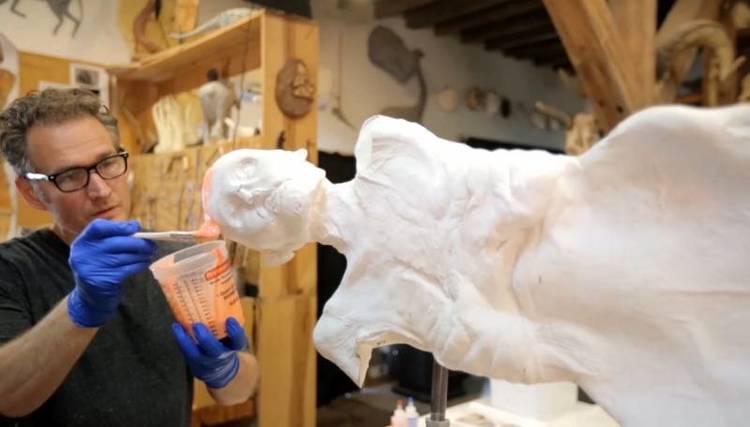


ROME -- Ötzi the Iceman, who is also known as the Homo tyrolensis, is one of the most famous and oldest mummies ever found. Discovered by two German tourists in the Oztel Alps in the Italian Tyrol near the border with Austria in 1991, the mummy was found encased in ice, wearing a coat of goat hide and waterproof boots. Its importance lies in the fact that his tattooed body lay untouched from the moment of his death almost 5,000 years ago, thus permitting not only reconstruction of his way of life, through his clothing and tools, but also analysis of his bones, blood and DNA.
Now a life-size replica of Ötzi, created by the American paleoartist Gary Staab, was presented Wednesday at the South Tyrol Museum of Archaeology at Bolzano (in German, Bozen), where the remains of Ötzi are on view in a specially constructed vacuum display cabinet. Describing the process of creating the replica, museum director Angelika Fleckinger explained that the mummy will be part of a new traveling exhibition about the discovery of the man now called "Ötzi"which will tour the U.S.A. and Canada beginning in October of 2017 in the North Carolina Museum of Natural Science at Raleigh.
The "extraordinary collaboration" behind creation of the mummy replica by Staab and his team, which required "many months" to complete, came about thanks to cooperation between the Bolzano museum and New York's Cold Spring Harbor DNA Learning Center, said Fleckinger. The first sculpture-like image of Ötzi had been made utilizing CT-scanned images and 3-D printing, which permitted creation of a resin replica. "After the blank had hardened, the mummy was sculpted and hand-painted by Staab," Fleckinger added. Two other images were subsequently created.
In early 2012 it was discovered that Ötzi's body still had intact blood cells, the oldest ever found. Although shrunken or mere remnants, the cells have the same dimensions as living red blood cells and resemble a modern-day sample. The images are used in teaching at the Cold Spring Harbor Center (DNALC). Directed by Dave Miklos, DNALC IS the world's biggest scientific learning center for genetics, whose 36,000 students study DNA in six research laboratories.
Because blood cells tend to degrade rapidly, early scans had been inconclusive, but newer DNA studies by Walther Parson of the Medical University of Innsbruck, in Austria, have revealed that, although his maternal genetic line originating in the Alps is now extinct, Ötzi has at least 19 living genetic relatives. DNA analysis also shows that, although he had spent his childhood in a village north of Bolzano called Feldthurns, he was related to inhabitants of the islands of Corsica and Sardinia, rather than in the Alpine regions where his body was discovered.
The model was made utilizing up-to-date forensic mapping technology, based upon 3-D images of his skull, plus infrared and tomographic images. The new studies indicate that Ötzi was perhaps 45 years old, approximately 5'3" tall, and brown eyed, with type "O" blood; earlier he had been believed to be between 30 and 45 years of age, and had blue eyes. The new 3-D technological reconstruction of his face also indicates that he wore a beard, and had a furrowed brow that made him look decidedly tired. Death was caused by a flint arrowhead that pierced his shoulder, as was discovered only a decade ago.
The whole process of reconstructing the mummy, and the scientific basis behind it, was filmed by the American production company NOVA for a 48-minute documentary "Iceman Reborn," broadcast on the PBS channel for US viewers.
To learn more, see >>> [2]
Source URL: http://test.casaitaliananyu.org/magazine/focus/art-culture/article/us-paleoartist-presents-otzi-mummy-replica-bolzano-museum
Links
[1] http://test.casaitaliananyu.org/files/otzi1461246809jpeg
[2] http://www.iceman.it/en/mummy-world-sensation